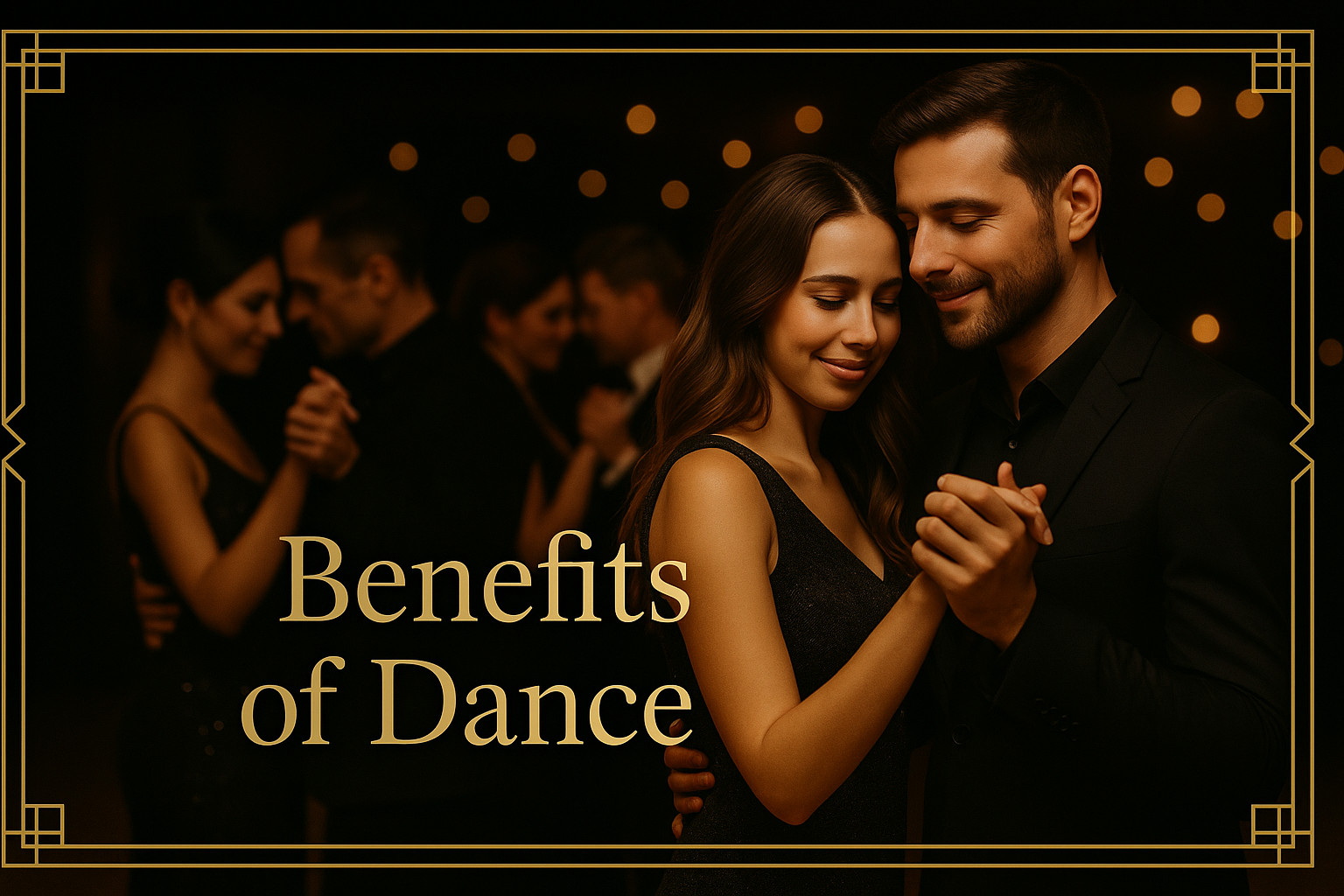Discover How Dance Transforms Body, Mind & Spirit
At OS Dance Productions, we believe dance isn’t just movement — it’s transformation. From fitness and balance to emotional well-being and connection, the benefits of ballroom and Latin dance ripple through every aspect of your life. Whether you’re looking for a new way to stay active, reconnect with your partner, or simply do something joyful for yourself — dance offers a pathway to a more confident, vibrant you.
Our students often tell us that dance changes far more than how they move — it transforms how they feel, connect, and live.
As you develop your dancing, don’t be surprised if you:
Find more fun, laughter, and excitement in your social life.
Feel more confident and at ease in any room.
Build new friendships and strengthen old ones.
Improve your health, balance, and overall energy.
Experience less stress and more fulfillment.
See your posture, presence, and poise evolve.
Deepen your relationship with your partner — on and off the floor.
Discover a form of fitness that never feels like exercise.
Bring more confidence to your business and personal life.
Learn to say “yes” to every opportunity to dance, celebrate, and connect.
Evidence in Every Step
Below are several scientific studies and real-world stories that highlight the proven physical, mental, and emotional benefits of dance — from strengthening your heart and bones to enhancing memory, balance, and overall well-being.
-
You’ve probably heard it before — taking regular walks is one of the best ways to maintain cognitive health as we age. Research from the National Institute on Aging and other neurological studies confirm that consistent, moderate physical activity like walking increases blood flow to the brain, strengthens neural connections, and helps delay the onset of Alzheimer’s disease.
But here’s what’s remarkable: while walking helps the body move, dance trains the brain to move with purpose.
Unlike walking in a straight line, dance combines rhythm, spatial awareness, decision-making, balance, and social interaction — all at once. Every time you learn a new step, recall choreography, or adjust to the beat of the music, your brain is firing in multiple regions simultaneously: memory, coordination, and emotion.
A single ballroom or Latin dance lesson can activate the same brain regions that benefit from several long walks, while also stimulating new neural connections through rhythm and movement. In short, dance is walking — elevated.
According to neurologists, the complexity of dance routines demands a higher level of mental engagement than repetitive physical activity. The combination of movement, music, and interaction creates what experts call “neuroplastic synergy” — a state that helps the brain stay adaptive and alert.
So while a walk might keep your body moving forward, dance moves your body and your mind — together.
-
According to the National Osteoporosis Society, dance is more than art — it’s science in motion.
Dr. Peter Lovatt, dance psychologist and principal lecturer at the University of Hertfordshire, explains:
“When people engage in social dance, there’s a measurable change in their mood. They become less fatigued, less depressed, and more energetic — even five minutes of dancing can help people think more sharply and creatively.”
But the benefits go far beyond mood. Dance contributes to heart and lung health, helps maintain a healthy weight, and, most importantly, strengthens bones and muscles through natural, weight-bearing movement.
Dr. Kate Ward, Senior Research Scientist at MRC Human Nutrition Research in Cambridge, notes that many ballroom and Latin styles — from Tango to Waltz — involve consistent weight shifts, rises, and turns that stimulate bone density and muscle resilience. This kind of activity not only supports bone maintenance but also improves balance and coordination, helping reduce the risk of falls and fractures later in life.
Professor Dawn Skelton of Glasgow Caledonian University adds that while dance’s direct impact on bones varies by style, the overall effect on balance and stability significantly lowers the risk of bone injury.
“Even if the impact on bone is not strong,” she says, “if people reduce their chances of falling, they’re less likely to fracture.”
-
Science now proves that a little time on the dance floor can do as much for your cardiovascular health as a session on the treadmill — and it’s far more enjoyable.
A large-scale study from the United Kingdom, involving over 48,000 adults aged 40 and older, found that people who danced regularly had a significantly lower risk of dying from heart disease. Participants who engaged in moderate-intensity dancing just a few times per week showed remarkable improvements in cardiovascular function and overall longevity.
It’s no wonder the American Heart Association officially recommends dance as one of the most effective forms of aerobic exercise. Unlike routine workouts, dance engages the entire body — rhythm, coordination, and expression combine to increase heart rate, circulation, and endurance.
Research published in the Journal of Physiological Anthropology found that dancing can be just as effective as cycling or jogging for improving aerobic capacity and supporting weight management. Just 30 minutes of continuous dancingcan burn 200 to 400 calories while toning muscles and improving posture. It’s fitness disguised as fun.
But the benefits go deeper than physical.
Dance also boosts mental and emotional well-being by stimulating endorphins — the body’s natural “feel-good” hormones. Studies in the International Journal of Neuroscience found that dance regulates serotonin and dopamine, neurotransmitters that help reduce anxiety, combat depression, and increase emotional resilience.
Every time you dance, you’re not just moving your body — you’re strengthening your heart, balancing your mind, and uplifting your spirit. Whether you’re gliding through a Waltz, laughing through a Swing, or losing yourself in the rhythm of a Cha Cha, your heart beats stronger with every step.
-
For those living with Parkinson’s disease, dance has emerged as one of the most inspiring and effective forms of therapy, helping individuals regain control, confidence, and connection through movement.
Parkinson’s is a progressive neurological condition that affects the brain’s ability to produce dopamine — the chemical responsible for coordinating smooth, purposeful movement. Symptoms often include tremors, stiffness, slowness, and balance challenges. Beyond the physical, it can also bring emotional weight: anxiety, fatigue, and depression.
While there’s currently no cure for Parkinson’s, research around the world — and countless personal stories — have shown that dance can dramatically improve both physical function and emotional well-being for those living with the disease.
One of the leading voices in this movement is Professor Rafi Eldor, an economist from Israel who was diagnosed with Parkinson’s several years ago. Told by doctors he might lose his independence within five years, he turned instead to ballroom dancing as a form of therapy. Through consistent dance practice, Professor Eldor found not only renewed mobility, but renewed purpose — using the rhythm of dance to retrain his body and mind to move as one.
His story is now echoed by thousands around the world who participate in Dance for Parkinson’s programs. These classes, built around principles of ballroom and social dance, help retrain essential motor functions like coordination, balance, and spatial awareness.
Unlike repetitive physical therapy routines, dance engages music, memory, and imagination — three powerful tools that work together to strengthen both body and brain. The rhythm acts as an external cue, guiding smoother motion; the music lifts mood and encourages consistency; and the community setting reduces feelings of isolation.
Neurologists have found that dancing activates multiple areas of the brain at once — including those involved in movement, balance, rhythm, and emotion. For individuals with Parkinson’s, this stimulation helps bypass damaged neural pathways and form new motor patterns through repetition and timing.
In studies across the U.S. and Europe, participants in dance therapy programs have shown measurable improvements in gait, coordination, posture, and overall mobility. More importantly, they report greater confidence, social connection, and quality of life.
Dr. Peter Lovatt, dance psychologist at the University of Hertfordshire, explains it simply:
“When we dance, we don’t just move our muscles — we move our minds. Dance reawakens the body’s natural intelligence.”
For people living with Parkinson’s, dance represents more than exercise — it’s a return to self.
It’s a chance to move freely, connect with others, and rediscover joy through music and motion.


